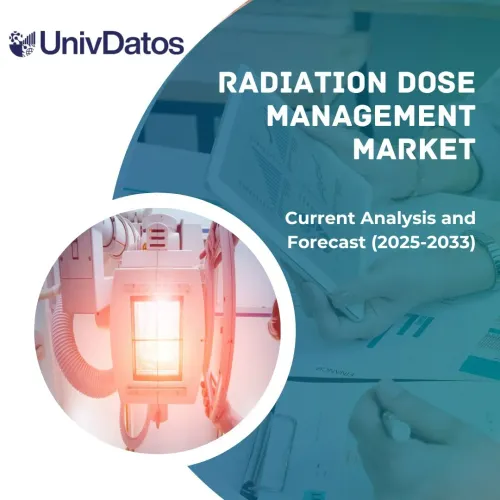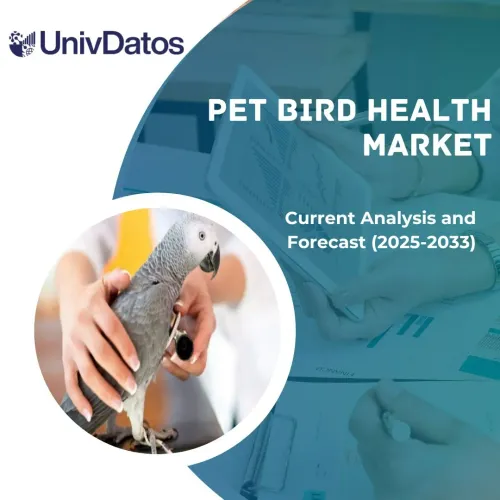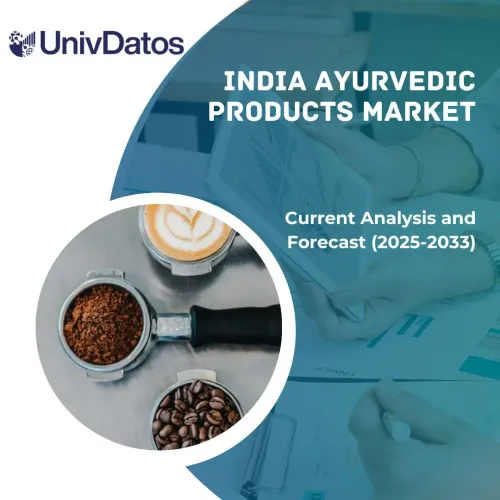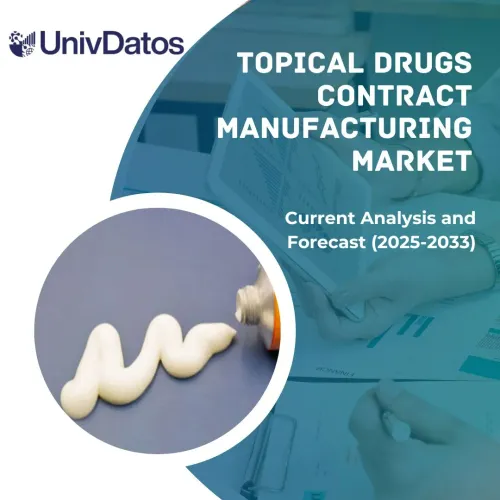- Startseite
- Über uns
- Industrie
- Dienstleistungen
- Lesen
- Kontaktieren Sie uns
Markt für bipolare Koagulatoren: Aktuelle Analyse und Prognose (2022-2028)
Betonung auf Produkttyp [Generatoren, Instrumente (Fortgeschrittene Gefäßversiegelungsinstrumente und bipolare Pinzetten), Zubehör (Elektroden, Kabel, Leitungen, Adapter, Fußschalter, Wagen)]; Anwendung (Laparoskopische Chirurgie, Orthopädie, Neurochirurgie, gynäkologische Chirurgie, Sonstige); Endverbraucher (Krankenhäuser, Traumazentren, Ambulante OP-Zentren, Sonstige); und Region/Land
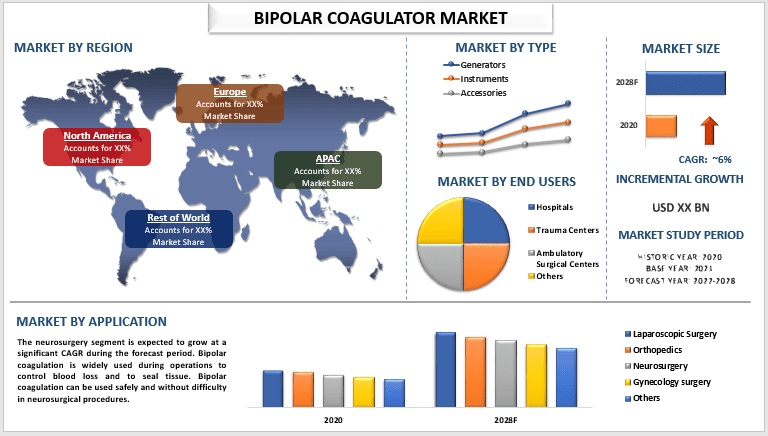
Es wird erwartet, dass der globale Markt für bipolare Koagulatoren während des Prognosezeitraums 2022-2028 mit einer signifikanten Rate von etwa 6 % wächst.Bipolare Koagulatoren werden in chirurgischen Eingriffen wie kardiovaskulärer Chirurgie, gynäkologischer Chirurgie, allgemeiner Chirurgie und anderen verwendet. Diese Geräte wenden elektrischen Strom zur thermischen Zerstörung des Zielgewebes an. Daher haben die wachsenden technologischen Entwicklungen in den medizinischen Wissenschaften zur Entwicklung moderner, hochentwickelter medizinischer Werkzeuge und Techniken geführt, die bei der Behandlung vieler Krankheiten und Störungen wie chronische Krankheiten und Tumore sehr wirksam sind.Laut der Weltgesundheitsorganisation (WHO) im Jahr 2021 sind verschiedene Arten chronischer Krankheiten wie Herz-Kreislauf-Erkrankungen, Krebs, Atemwegserkrankungen und Diabetes für etwa 17,9 Millionen, 9,3 Millionen, 4,1 Millionen bzw. 1,5 Millionen Todesfälle verantwortlich.Große Unternehmen auf dem Markt bieten Produkteinführungen und Produktzulassungen mit technologisch fortschrittlichen Funktionen an.So brachte beispielsweise Encision Inc., ein Entwickler von aktiver Elektrodenüberwachungstechnologie, die gefährliche Elektroschäden bei minimalinvasiven Eingriffen verhindert, im August 2020 die AEM 2X enTouch Scissors auf den Markt, ein Instrument zur chirurgischen Verwendung zum Schneiden, Bohren, Sägen, Kratzen, Schaben, Klemmen, Zurückziehen, Clippen oder ähnlichen Verfahren.
- Braun SE, Symmetry Surgical Inc., Apyx Medical, Medtronic, XCELLANCE MEDICAL TECHNOLOGIES PVT LTD, Olympus Corporation, Karl Storz, CONMED Corporation, Boston Scientific Corporation, Smith & Nephew sind einige der wichtigsten Akteure auf dem Markt. Mehrere Fusionen und Übernahmen sowie Partnerschaften wurden von diesen Akteuren durchgeführt, um Kunden mit High-Tech- und innovativen Produkten/Technologien zu unterstützen.
In der Studie präsentierte Erkenntnisse
„Es wird erwartet, dass Elektroden unter den Produkttypen während des Prognosezeitraums mit einer signifikanten CAGR wachsen“
Basierend auf dem Produkttyp ist der Markt in Generatoren, Instrumente und Zubehör unterteilt. Instrumente sind in fortgeschrittene Gefäßversiegelungsinstrumente und bipolare Pinzetten unterteilt. Zubehör ist in Elektroden, Kabel, Leitungen, Adapter, Fußschalter und Wagen unterteilt. Unter diesen wird erwartet, dass Elektroden während des Prognosezeitraums mit einer signifikanten CAGR wachsen. Dies ist hauptsächlich auf die zunehmende Verbreitung chronischer Krankheiten, die zunehmende Einführung minimalinvasiver Verfahren weltweit und die technologischen Fortschritte zurückzuführen, die den Patientenanforderungen angeboten werden.Laut dem CDC-Bericht 2020 wurden 90 % der Gesundheitskosten der Nation in Höhe von 3,8 Billionen USD pro Jahr wahrscheinlich auf Menschen mit chronischen Krankheiten und psychischen Erkrankungen zurückgeführt.
Marktbericht für bipolare Koagulatoren: Abdeckung
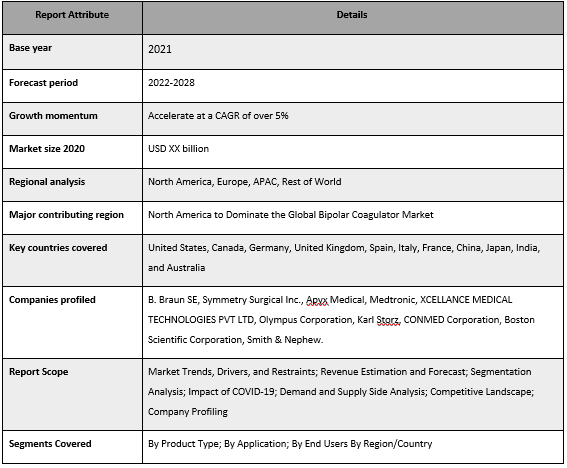
„Unter den Anwendungen hielt die laparoskopische Chirurgie im Jahr 2020 einen erheblichen Marktanteil“
Basierend auf der Anwendung wird der Markt in laparoskopische Chirurgie, Orthopädie, Neurochirurgie, gynäkologische Chirurgie und andere kategorisiert. Unter diesen hielt das Segment der laparoskopischen Chirurgie im Jahr 2020 einen erheblichen Marktanteil. Laparoskopische Chirurgie bezieht sich auf chirurgische Eingriffe, die durch einen oder mehrere kleine Schnitte durchgeführt werden. Diese minimalinvasive chirurgische Technik ist mit einer schnelleren Genesung und besseren Patientenergebnissen verbunden, was das Segment antreibt.Beispielsweise gab Genesis MedTech, ein Unternehmen für Medizinprodukte, im April 2021 die Einführung einer neuartigen laparoskopischen Technologie in Singapur und China bekannt.
„Nordamerika wird einen signifikanten Marktanteil halten“
Im Jahr 2020 hielt Nordamerika einen signifikanten Anteil am globalen Markt für bipolare Koagulatoren. Dies ist hauptsächlich auf die steigende Inzidenz von Herz-Kreislauf- und neurologischen Erkrankungen zurückzuführen, die zu einer Zunahme chirurgischer Eingriffe führen können.Laut den Centers for Disease Control and Prevention (CDC) stirbt im Jahr 2022 in den Vereinigten Staaten alle 36 Sekunden eine Person an Herz-Kreislauf-Erkrankungen.Darüber hinaus wird erwartet, dass Faktoren wie eine innovative medizinische Infrastruktur und ein hohes verfügbares Einkommen eine Rolle spielen. Das Vorhandensein führender Akteure wie CONMED Corporation, Boston Scientific Corporation und Smith & Nephew bietet bipolare Koagulatoren für chirurgische Eingriffe mit technologisch fortschrittlichen Funktionen an.So gab die Boston Scientific Corporation im Dezember 2020 die FDA-Zulassung für ihr ORISE ProKnife bekannt, das zur Verwendung mit Endoskopeinheiten zum Schneiden von Gewebe im Magen-Darm-Trakt mit Hochfrequenzstrom entwickelt wurde.
Gründe für den Kauf dieses Berichts:
- Die Studie umfasst die Marktgrößen- und Prognoseanalyse, die von authentifizierten wichtigen Branchenexperten validiert wurde.
- Der Bericht gibt einen schnellen Überblick über die Gesamtleistung der Branche auf einen Blick.
- Der Bericht enthält eine eingehende Analyse prominenter Branchenkollegen mit einem Schwerpunkt auf wichtigen Geschäftsfinanzen, Produktportfolio, Expansionsstrategien und aktuellen Entwicklungen.
- Detaillierte Untersuchung der in der Branche vorherrschenden Treiber, Einschränkungen, wichtigsten Trends und Chancen.
- Die Studie deckt den Markt umfassend über verschiedene Segmente ab.
- Detaillierte Analyse der Branche auf regionaler Ebene.
Optionen zur Anpassung:
Der globale Markt für bipolare Koagulatoren kann weiter an die Anforderungen oder jedes andere Marktsegment angepasst werden. Darüber hinaus versteht UMI, dass Sie möglicherweise Ihre eigenen Geschäftsanforderungen haben, daher können Sie sich gerne mit uns in Verbindung setzen, um einen Bericht zu erhalten, der Ihren Anforderungen vollständig entspricht.
Inhaltsverzeichnis
Forschungsmethodik für die Marktanalyse für bipolare Koagulatoren (2022-2028)
Die Analyse des historischen Marktes, die Schätzung des aktuellen Marktes und die Prognose des zukünftigen Marktes des globalen Marktes für bipolare Koagulatoren waren die drei wichtigsten Schritte, die unternommen wurden, um die Einführung von bipolaren Koagulatoren in den wichtigsten Regionen weltweit zu erstellen und zu analysieren. Es wurden umfassende Sekundärrecherchen durchgeführt, um die historischen Marktzahlen zu sammeln und die aktuelle Marktgröße zu schätzen. Zweitens wurden zur Validierung dieser Erkenntnisse zahlreiche Ergebnisse und Annahmen berücksichtigt. Darüber hinaus wurden umfassende Primärinterviews mit Branchenexperten in der gesamten Wertschöpfungskette des globalen Marktes für bipolare Koagulatoren durchgeführt. Nach der Annahme und Validierung der Marktzahlen durch Primärinterviews haben wir einen Top-Down/Bottom-Up-Ansatz verwendet, um die gesamte Marktgröße zu prognostizieren. Danach wurden Methoden zur Marktaufteilung und Datentriangulation angewendet, um die Marktgröße von Segmenten und Untersegmenten der Branche zu schätzen und zu analysieren. Die detaillierte Methodik wird im Folgenden erläutert:
Analyse der historischen Marktgröße
Schritt 1: Eingehende Untersuchung von Sekundärquellen:
Es wurde eine detaillierte Sekundärstudie durchgeführt, um die historische Marktgröße des Marktes für bipolare Koagulatoren durch unternehmensinterne Quellen wieJahresberichte und Finanzberichte, Leistungsvorstellungen, Pressemitteilungen usw.und externe Quellen einschließlichZeitschriften, Nachrichten & Artikel, Veröffentlichungen der Regierung, Veröffentlichungen der Wettbewerber, Branchenberichte, Datenbanken von Drittanbietern und andere glaubwürdige Veröffentlichungen.
Schritt 2: Marktsegmentierung:
Nachdem wir die historische Marktgröße des Marktes für bipolare Koagulatoren erhalten hatten, führten wir eine detaillierte Sekundäranalyse durch, um historische Markteinblicke und Anteile für verschiedene Segmente und Untersegmente für wichtige Regionen zu sammeln. Wichtige Segmente sind im Bericht enthalten, wie Produkttyp, Anwendung, Endverbraucher. Darüber hinaus wurden Analysen auf Länderebene durchgeführt, um die allgemeine Akzeptanz von Testmodellen in dieser Region zu bewerten.
Schritt 3: Faktorenanalyse:
Nachdem wir die historische Marktgröße verschiedener Segmente und Untersegmente ermittelt hatten, führten wir eine detaillierteFaktorenanalysedurch, um die aktuelle Marktgröße des Marktes für bipolare Koagulatoren zu schätzen. Darüber hinaus führten wir eine Faktorenanalyse unter Verwendung abhängiger und unabhängiger Variablen wie Typ, Anwendung, Endverbraucher von bipolaren Koagulatoren durch. Es wurde eine gründliche Analyse für Nachfrage- und Angebotszenarien unter Berücksichtigung der wichtigsten Partnerschaften, Fusionen und Übernahmen, Geschäftserweiterungen und Produkteinführungen im Sektor für bipolare Koagulatoren auf der ganzen Welt durchgeführt.
Schätzung & Prognose der aktuellen Marktgröße
Aktuelle Marktgröße:Basierend auf umsetzbaren Erkenntnissen aus den oben genannten 3 Schritten, sind wir zur aktuellen Marktgröße, den Hauptakteuren im globalen Markt für bipolare Koagulatoren und den Marktanteilen der Segmente gelangt. Alle erforderlichen prozentualen Anteile, Aufteilungen und Marktgliederungen wurden anhand des oben genannten sekundären Ansatzes ermittelt und durch Primärinterviews verifiziert.
Schätzung & Prognose:Für Marktschätzungen und -prognosen wurden verschiedenen Faktoren, einschließlich Treibern und Trends, Beschränkungen und Chancen für die Interessengruppen, Gewichte zugewiesen. Nach der Analyse dieser Faktoren wurden relevante Prognosetechniken, d. h. der Top-Down-/Bottom-Up-Ansatz, angewendet, um zur Marktprognose für 2028 für verschiedene Segmente und Untersegmente in den wichtigsten Märkten weltweit zu gelangen. Die zur Schätzung der Marktgröße angewandte Forschungsmethodik umfasst:
- Die Marktgröße der Branche, in Bezug auf den Umsatz (USD) und die Adoptionsrate des Marktes für bipolare Koagulatoren in den wichtigsten Märkten im Inland
- Alle prozentualen Anteile, Aufteilungen und Gliederungen von Marktsegmenten und Untersegmenten
- Hauptakteure auf dem globalen Markt für bipolare Koagulatoren in Bezug auf die angebotenen Produkte. Außerdem die Wachstumsstrategien, die diese Akteure anwenden, um in dem schnell wachsenden Markt zu konkurrieren
Marktgrößen- und -anteilsvalidierung
Primärforschung:Tiefgehende Interviews wurden mit den Key Opinion Leaders (KOLs) durchgeführt, darunter Top-Level-Führungskräfte (CXO/VPs, Vertriebsleiter, Marketingleiter, Betriebsleiter, Regionalleiter, Landesleiter usw.) in den wichtigsten Regionen. Die Ergebnisse der Primärforschung wurden dann zusammengefasst und eine statistische Analyse durchgeführt, um die aufgestellte Hypothese zu belegen. Die Ergebnisse der Primärforschung wurden mit den Ergebnissen der Sekundärforschung konsolidiert, wodurch Informationen in umsetzbare Erkenntnisse umgewandelt wurden.
Aufteilung der primären Teilnehmer in verschiedenen Regionen
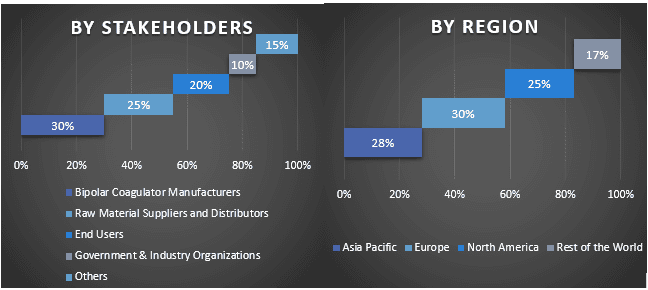
Markttechnik
Die Datentriangulationstechnik wurde eingesetzt, um die gesamte Marktschätzung abzuschließen und genaue statistische Zahlen für jedes Segment und Untersegment des globalen Marktes für bipolare Koagulatoren zu erhalten. Die Daten wurden nach der Untersuchung verschiedener Parameter und Trends in den Bereichen Typ, Anwendung und Endverbraucher auf dem globalen Markt für bipolare Koagulatoren in mehrere Segmente und Untersegmente aufgeteilt.
Das Hauptziel der Global Bipolar coagulator Market Study
Die aktuellen und zukünftigen Markttrends des globalen Marktes für bipolare Koagulatoren wurden in der Studie ermittelt. Investoren können strategische Erkenntnisse gewinnen, um ihre Entscheidungen für Investitionen auf der Grundlage der in der Studie durchgeführten qualitativen und quantitativen Analysen zu treffen. Aktuelle und zukünftige Markttrends bestimmten die Gesamtattraktivität des Marktes auf regionaler Ebene und boten dem industriellen Teilnehmer eine Plattform, um den unerschlossenen Markt zu nutzen und von einem First-Mover-Vorteil zu profitieren. Weitere quantitative Ziele der Studien umfassen:
- Analysieren Sie die aktuelle und prognostizierte Marktgröße des Marktes für bipolare Koagulatoren in Bezug auf den Wert (USD). Analysieren Sie auch die aktuelle und prognostizierte Marktgröße verschiedener Segmente und Untersegmente
- Zu den Segmenten in der Studie gehören Bereiche wie Typ, Anwendung und Endbenutzer.
- Definition und Analyse des regulatorischen Rahmens für den bipolaren Koagulator
- Analysieren Sie die Wertschöpfungskette, die mit der Präsenz verschiedener Intermediäre verbunden ist, sowie das Kunden- und Wettbewerbsverhalten der Branche.
- Analysieren Sie die aktuelle und prognostizierte Marktgröße des Marktes für bipolare Koagulatoren für die wichtigsten Regionen.
- Zu den wichtigsten Ländern der in dem Bericht untersuchten Regionen gehören der asiatisch-pazifische Raum, Europa, Nordamerika und der Rest der Welt.
- Unternehmensprofile des Marktes für bipolare Koagulatoren und die Wachstumsstrategien, die die Marktteilnehmer anwenden, um sich in dem schnell wachsenden Markt zu behaupten
- Detaillierte Analyse der Branche auf regionaler Ebene
Verwandt Berichte
Kunden, die diesen Artikel gekauft haben, kauften auch


